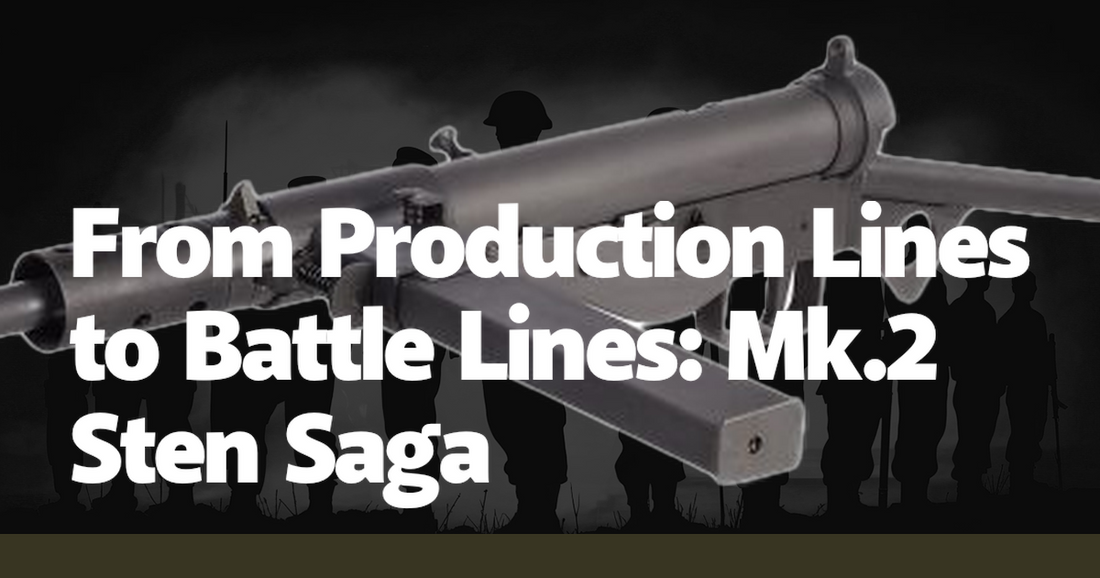The Mk.2 Sten submachine gun, a symbol of British ingenuity during World War II, represents a fascinating journey from production lines to battle lines. Born out of necessity, the Sten was a response to the desperate need for a cost-effective, easily manufactured weapon that could be produced quickly to arm Allied forces. The British Army, facing the prospect of invasion and severe equipment shortages, needed a solution that could be rapidly deployed. The Sten, with its simple design and low production cost, became that solution. Its creation was not just a technical achievement but a testament to the resilience and resourcefulness of a nation under siege.
The production of the Mk.2 Sten began in 1941, a time when Britain was grappling with the relentless onslaught of the Axis powers. Factories across the UK were retooled to mass-produce these submachine guns, employing a workforce that included many women and older men who were not eligible for front-line service. The Sten's design was deliberately straightforward, consisting of a steel tube, a spring, and a bolt – components that could be assembled with minimal machining. This simplicity allowed for rapid production, with some estimates suggesting that a single Sten could be manufactured in just five hours. The weapon's crude appearance belied its effectiveness, as it was designed to be reliable and easy to use in the chaotic conditions of war.
On the battlefield, the Mk.2 Sten quickly proved its worth. Its compact size and lightweight construction made it ideal for the close-quarters combat that characterized much of the fighting in Europe. British paratroopers, commandos, and resistance fighters all relied on the Sten for its firepower and portability. Anecdotes from veterans highlight the Sten's role in pivotal battles and covert operations. For instance, during the Normandy invasion, paratroopers used the Sten to great effect in the initial hours of the assault, its rapid rate of fire providing crucial support as they secured key objectives. The weapon's ability to use captured German 9mm ammunition also proved advantageous, ensuring that soldiers could continue fighting even when supply lines were stretched thin.
However, the Mk.2 Sten was not without its flaws. Its simplicity, while a strength in production, sometimes led to operational issues. Soldiers often complained about the weapon's tendency to jam, especially if it was not meticulously cleaned. The side-mounted magazine, a distinctive feature of the Sten, was particularly prone to causing feeding problems if not handled correctly. Despite these issues, the Sten remained a beloved weapon among many troops, who appreciated its ruggedness and the sheer volume of fire it could deliver. Stories from the front lines often recount soldiers' inventive solutions to the Sten's quirks, such as using bootlaces to secure the magazine and prevent misfeeds.
The Mk.2 Sten also played a significant role in the clandestine operations of the Special Operations Executive (SOE) and various resistance movements across occupied Europe. The weapon's ease of concealment and the ability to be disassembled and reassembled quickly made it ideal for guerrilla warfare. Resistance fighters in France, Norway, and the Netherlands used the Sten to conduct ambushes, sabotage missions, and assassinations, often under the cover of night. The psychological impact of these operations, bolstered by the Sten's distinctive sound, cannot be overstated. The Sten became a symbol of defiance and hope for those living under occupation, a tangible representation of the ongoing struggle against tyranny.
In the post-war years, the legacy of the Mk.2 Sten continued to resonate. Surplus Stens found their way into numerous conflicts around the world, from the Israeli War of Independence to various colonial wars in Africa and Asia. Its design influenced subsequent generations of submachine guns, and its impact on military tactics and small arms development remains evident. The Sten's story is not just one of a weapon, but of the people who designed, built, and wielded it in the fight for freedom. The ingenuity that went into its creation and the bravery of those who used it are enduring testaments to the human spirit's capacity to innovate and persevere in the face of adversity.
The Mk.2 Sten's influence extended beyond the battlefield into popular culture, where it became an iconic image of World War II. Films, books, and video games have all featured the Sten, often highlighting its role in daring commando raids and resistance operations. This cultural representation has helped to cement the Sten's place in the collective memory of the war, serving as a reminder of the extraordinary circumstances that led to its creation and the remarkable individuals who relied on it. The Sten's presence in media also serves an educational purpose, introducing new generations to the history of World War II and the technological and human challenges faced during that time.
Reflecting on the Mk.2 Sten's saga, it is clear that this unassuming submachine gun was much more than a piece of military hardware. It was a symbol of resilience, innovation, and determination in the face of overwhelming odds. The story of the Sten is a microcosm of the broader narrative of World War II, encapsulating the desperation, ingenuity, and heroism that defined the era. As we continue to study and remember the history of the war, the Mk.2 Sten stands as a powerful reminder of the lengths to which humanity will go to defend freedom and overcome adversity. Its legacy endures, not just in the annals of military history, but in the enduring spirit of those who fought for a better world.

